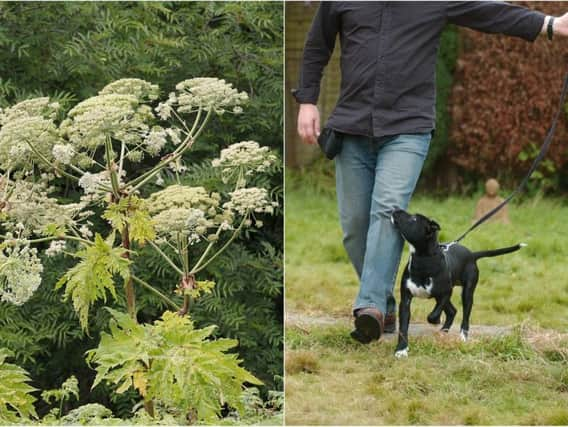Police warning after dog is injured brushing against 'UK's most dangerous plant' giant hogweed


West Yorkshire Police's Wildlife and Rural Crime team issued the warning after a dog in the region was injured after brushing against some giant hogweed.
-> Wanted: 16 people police urgently want to speak to in Leeds The plant can cause severe burns to humans but it is particularly dangerous to dogs.
Advertisement
Hide AdAdvertisement
Hide AdThe team posted on social media: "We are aware of an incident where a dog has been injured by brushing against some giant hogweed.
"Please be aware of what the plant looks like and avoid touching the plant."
The force did not specify where the incident took place.
-> This is the incredible moment a brave Yorkshire child waiting for a heart donation met her hero Lewis Capaldi backstageToxic sap from the weed, which grows near canals and rivers, can increase the sensitivity of the skin to sunlight, often leading to burns - and can cause temporary or even permanent blindness if the sap gets into the eye.
It comes just months after people were warned to avoid several patches of giant hogweed found near the River Aire in Kirkstall.Incredible Edible Kirkstall spotted it at Kirkstall Goit, near to the Ready Steady Store, close to Beecroft and Sacred Heart primary schools, with patches spreading down towards Asda and beyond.
Advertisement
Hide AdAdvertisement
Hide AdWarning signs were put up around some of the plants and they were in the process of being removed.
Giant hogweed has been described as 'the most dangerous plant in Britain' by the Mersey Basin Rivers Trust.
What is giant hogweed?
Giant hogweed (Heracleum mantegazzianum) is a plant in the Apiaceae family (previously known as the Umbelliferae).
This family includes some well-known plants such as parsley, carrot, parsnip, cumin and coriander.
Where does giant hogweed grow?
Advertisement
Hide AdAdvertisement
Hide AdGiant hogweed is not native to the UK. It originates from the Caucasus Mountains and Central Asia.
It was first introduced to the UK as an ornamental in the 19th century where it escaped and naturalised in the wild.
It can now be found throughout much of the UK, especially colonising river banks where its seeds are transported by the water.
What does giant hogweed look like?
Giant hogweed looks like an enormous cow parsley.
When it's fully grown, it can reach towering heights of between 1.5m to 5m and have a spread of between 1 and 2m.
Advertisement
Hide AdAdvertisement
Hide AdIt forms a rosette of jagged, lobed leaves in the first year before sending up a flower spike in the second year and then setting seed.
Stems: green with purple blotches and stiff, white hairs. Stems are hollow with ridges and have a thick circle of hairs at base of each leaf stalk.
Leaves: huge, up to 1.5m wide and 3m long and is deeply divided into smaller leaflets. It looks a bit like a rhubarb leaf, with irregular and very sharp or jagged edges - which has given rise to one of its other common names - wild rhubarb.The underside of the leaf is hairy.
Flowers: appear in June and July. They are small and white (or slightly pink) and are clustered on umbrella-like heads known as umbels that can reach a diameter of 60cm. All the flowers on the umbel face upwards.
Advertisement
Hide AdAdvertisement
Hide AdSeeds: dry, flattened, and oval. Almost 1cm long with tan with brown lines extending 3/4 of the seed length.
Is giant hogweed dangerous?
In short - the sap of giant hogweed can cause burns. It contains furocoumarin, which makes skin extremely sensitive to sunlight (phytophotodermatitis).
If the sap gets onto your skin, then you are exposed to sun, your skin can blister badly and blistering can recur over months and even years.
This is known as phytotoxicity.
The best way to avoid injury is to familiarise yourself with the plant.
Advertisement
Hide AdAdvertisement
Hide AdAvoid brushing through patches of giant hogweed and exposing yourself to plants which have been cut which might cause you to get sap on your skin.
What happens if you touch giant hogweed?
If you do get giant hogweed sap on your skin, be sure to wash the area thoroughly immediately, seek medical advice, and do not expose the area to sunlight for a few days.
(Source: Woodland Trust)